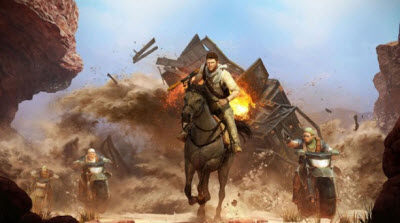 Uncharted 3: Drake’s Deception is one of the best video games of the year. It is the flagship of Sony’s games on the PlayStation 3 this fall and shipped 3.8 million copies on its first day of sales on Nov. 1. We described it as one of the best but also one of the most annoying games yet in the series from Sony’s Naughty Dog studio.
Uncharted 3: Drake’s Deception is one of the best video games of the year. It is the flagship of Sony’s games on the PlayStation 3 this fall and shipped 3.8 million copies on its first day of sales on Nov. 1. We described it as one of the best but also one of the most annoying games yet in the series from Sony’s Naughty Dog studio.
Justin Richmond, game director at Naughty Dog, told us about the big decisions that the company made as it began work on the title two years ago, after the previous title Uncharted 2: Among Thieves title walked away with most of the “game of the year awards.” Once again, Uncharted 3 is going to be a strong contender for top-game status. To stay on top, the company did everything from sending its developers to the desert to experience sand storms to completely rewriting the way the game played compared to Uncharted 2.
We thought it would be good to delve into the thinking behind the game and why it turned out the way it did. Here’s our edited transcript with Richmond (pictured right).
VB: You are game director on Uncharted 3. What exactly does that mean?
JR: Amy Hennig, our creative director, handles most of the writing and the story, and I handle the game design and the actual game plan. I try to work with Amy to make sure that it works as well as possible with the story.
VB: And where in the hierarchy does that put the two of you?
JR: Evan Wells and Christophe Balestra are the co-presidents, and Amy and I report to them.
VB: Can you take me back to when you guys finished Uncharted 2? How did you feel about how that game turned out, and what did you decide to do with Uncharted 3?
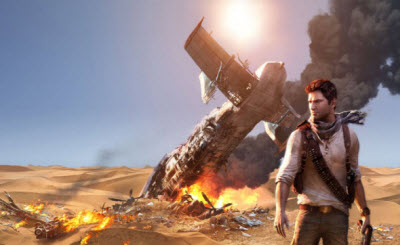 JR: We were obviously all super happy with how Uncharted 2 came out. It was one of the million games where it was the right game at the right time and everybody wanted it. I think we did a great game. At its peak, it came out when the industry really wanted that style of game, and people swept it up. That was awesome. So right away we started talking about where we go from making a “game of the year” to our next game. How do we try to keep up with that? We started looking at how we make a new story that’s interesting and make brand new set pieces and game play that is fresh and keeps you coming back to the game.
JR: We were obviously all super happy with how Uncharted 2 came out. It was one of the million games where it was the right game at the right time and everybody wanted it. I think we did a great game. At its peak, it came out when the industry really wanted that style of game, and people swept it up. That was awesome. So right away we started talking about where we go from making a “game of the year” to our next game. How do we try to keep up with that? We started looking at how we make a new story that’s interesting and make brand new set pieces and game play that is fresh and keeps you coming back to the game.
So we latched on right away to trying to make a brand new melee system. We wanted to make a game that had even better hand-to-hand combat than we did the game before and then, on top of that, try to make a brand new enemy who is more insidious and gets inside your head and messes with you. That is our Katherine Marlowe character. She is part of the game’s tradition of secret societies in Britain and is Drake’s main nemesis in this game. That was something different for us as well. And then on top of that trying to make sure that our set pieces at our big moment were even bigger than they were last time.
VB: So remind us what the melee system was like for Uncharted 2. What was different?
JR: In Uncharted 2, you basically can only fight one person at a time in hand-to-hand combat. It was all using the square and triangle buttons. In this game, we added a bunch of stuff. You can fight many more guys at the same time. We added other systems, like using the circle button to fight off a hold. We added different combo systems for punching and grabs ducks to make the game play even more interesting. We added a new character, called the Drew, which has a whole different system of hand-to-hand fighting than the regular guys.
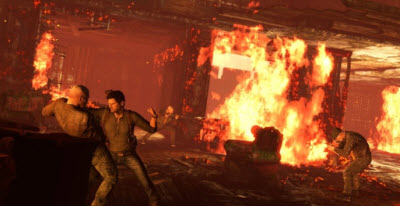 VB: The melees were interesting and had a lot of variety, but I felt like I ran into some of the same fights over and over again.
VB: The melees were interesting and had a lot of variety, but I felt like I ran into some of the same fights over and over again.
JR: Other people had the same reaction, and that is certainly something we look at adjusting in the future. But I think the fights were fun. I think one of things we realized afterwards is that it is tricky to make people realize that the big guy is actually a different guy every time. I think what we could have done there is identify him as him being a classic character and using him more like a class rather than as a special set piece.
VB: I actually thought the same guy was coming back over and over and over.
JR: Yeah, we have heard that before, and that is something we definitely need to address if we are going to do another one of these things. That is something we will look at.
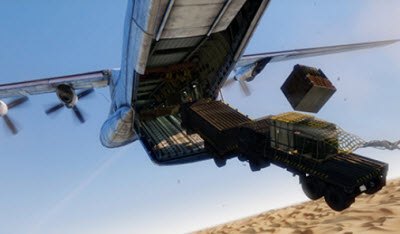 VB: Before we go into nitpicking these points, the game has received great reviews. I’m sure you guys must feel pretty good about it.
VB: Before we go into nitpicking these points, the game has received great reviews. I’m sure you guys must feel pretty good about it.
JR: Obviously we are happy that people want to follow us on another one of these adventures. It is always nerve-racking to put these things out and let your baby go and have people actually review it and play it and all that kind of stuff. But this year it has been overwhelmingly positive, and that is great. We are happy that the fans are happy.
VB: What would say was different about development this time?
JR: It was about the same size team, around 90 full-time developers and another 20 or 30 contractors. So the teams were roughly the same in size. But I think the biggest thing this time was just how much more we had to work to get the big custom set pieces (major scenes) done. We had to work more on the subtleties of the game so that we can make the game even better than last time. We had done so much work last time. Getting those last few things nailed down this time and getting the big set pieces to work the way you want them was very hard. We were going for a lot more nuanced stuff. That always takes a lot more time; and on top of that we are trying to do some very technically difficult set pieces.
And so I think the biggest thing in the process this time was just us trying to figure out bang for your buck. Was the scene worth it? What wasn’t worth it? We really went for it on scenes like the cruise ship. For example, we had to make sure that the waves hitting the cruise ship were right. You would have to flip over and fall 90 degrees or 180 degrees on the cruise ship, with this sense of vertigo. Those technical things were a lot scarier than they were last time. This time we just took it up a whole notch. At the same time, we were trying to make an interesting story and a nuanced story. That made development tricky. We had to make sure the game mechanics worked and we didn’t break our systems as they all came together.
 VB: Some people reading this may not have played the game yet. Would you describe what you call a “set piece”? What happens with the character of Drake in one of these scenes?
VB: Some people reading this may not have played the game yet. Would you describe what you call a “set piece”? What happens with the character of Drake in one of these scenes?
JR: One of the touchstone parts of Uncharted as a franchise is that you feel like you are playing in an action-adventure movie. What we try to do is we have this big amazing scenes that you would see in an action movie. In the previous game, it was a building falling down as a helicopter shot at you while you were inside the building, or the scene on the train where you were walking in a wobbly way on top of the train and were trying to shoot at the same time. In this one, it is the scene on the cruise ship where you are outrunning the rushing water and the scene on the cargo plane where you are trying to shoot while people are getting sucked out of the hole in the plane. Those scenes have Drake riding on a moving jeep so that he can jump on a moving plane as it’s about to take off. The plane crashes into the desert, and you play this sequence all in the real-time. The cruise ship is moving under Drake’s feet at the same time he is fighting the other enemies. The boat flips over, and you have to run on the side of the hallway.
VB: You’re pointing to some of the scenes that show the limits of what you can do. I think the physics of making the shooting work while you are actually falling off the plane or you are just like moving around on the cruise ship seems very difficult.
JR: Yeah, thank you for noticing that. It is tricky. That and the cruise ship and a couple of the scenes at the end of the game took a lot of work. You are still able to control Drake in the way that you want to, but it also feels like he is out of control when he is falling off the plane.
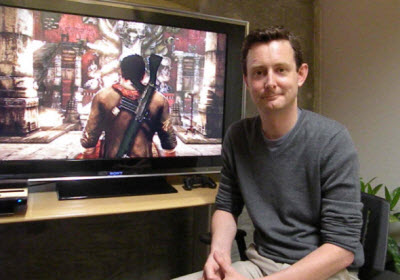 VB: I assume that is one of the points where you’re really taxing the hardware of the PlayStation 3?
VB: I assume that is one of the points where you’re really taxing the hardware of the PlayStation 3?
JR: It is all taxing. I think the trick is to, at any given point, push it as hard as we can. We try to push the graphics really hard, and when you are on the third installment in a series you feel like you max out the hardware. On the boat, animating all of that stuff is hard. We use every single bit of the processing power that we possibly can. But after the game is done, then you go back and look at it. And then you find that we could have been more intelligent about how we did this. We could have optimized this better and tried to get even more power out of the machine.
VB: I think when we interviewed (Naughty Dog’s) Richard Lemarchand (pictured) last time, he was talking about the power of the box and said that the original Uncharted may have used like 30 percent of the Cell processor in the PS 3 and that the second time around it was more like 80 percent or 90 percent. What did you use this time?
JR: We were, at any given point, using 100 percent. We were using everything we possibly could. There is always room where you find something where you can do the processing in some different way to find more power. There are all of these different ways to squeeze more power out of the box.
VB: By and large, the game ran well for me. One problem I noticed and I think other gamers have noticed is that when you are turning while you are aiming, it takes 10 seconds to do a 360-degree turn. That was really slow. I wondered if that was a horsepower limitation of the hardware?
JR: Actually, when we did play tests, we found that most people wanted it to turn at that rate because it felt like if they turned any faster, they couldn’t aim right. They couldn’t get a bead on other characters. That was about the speed that you can aim at. You can increase that speed by messing with the controller settings to make your speed faster or slower. But in general that was the average that people seemed to like.
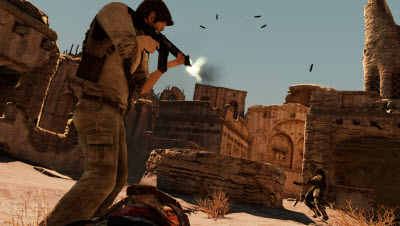 VB: And then I guess some people still had complaints about the accuracy of aiming?
VB: And then I guess some people still had complaints about the accuracy of aiming?
JR: We are definitely looking at that. We have taken into account all that stuff and tried to figure out where people are having problems. We are looking at what we can do to help people in that arena. We haven’t announced anything, but we are definitely looking at it.
VB: It sounds like the aiming was different from Uncharted 2 in some way, right?
JR: The whole system is completely different. When we started Uncharted 3, we found that at the end of Uncharted 2, people were telling us they were missing targets because of the way the aiming behavior worked. We adjusted that and tried to fix it in this game. I think there is some amount of adjustment that people need to make. But also there clearly are some people who seem to have more difficulty aiming in the game. In some cases, we are looking at what we can do to help those people. I think by and large those people are a minority.
VB: So the hardware is not limiting any of the game play right now?
JR: No. I don’t think so. Hardware is always going to limit you in some sense, which is good. You want to have something that says you can’t go too far. You want to design in some kind of limit, but, no, I think mostly whatever we can dream up that sits in the universe and we feel like is fun to play, we can do. We are not hitting the limit of what can be done. We are thinking more about what we want to do and how we want to play it.
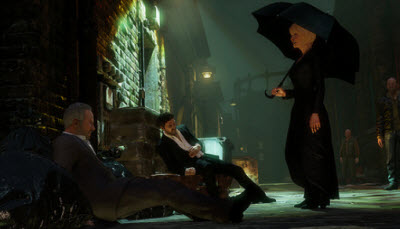 VB: I noted in our review that so much happens in the cinematic form at the beginning of the game. You tell so much of a story in a movie-like way, and I think it is maybe level four or five before you actually start any shooting. Can you talk about that beginning and how you thought about this?
VB: I noted in our review that so much happens in the cinematic form at the beginning of the game. You tell so much of a story in a movie-like way, and I think it is maybe level four or five before you actually start any shooting. Can you talk about that beginning and how you thought about this?
JR: Sure. I don’t want to ruin anything for people who haven’t played it yet. But we spent lot of time trying to figure out exactly how we wanted to start the game out. We wanted to have this big brawl, this big set piece. We show them how to do the melee system and then show them something of what is happening in the story but not exactly what is happening for the sake of mystery. But then obviously the second and third levels are completely different from anything we have done before. It is really nice that at the beginning of the game, you get the sort of more to know about Drake. Who is he? Where does he come from? All of these kinds of things. And then the player is eased into the shooting. That’s better than starting off with a weapon and trying to learn it right a way. I think it is something that the fans really liked and have had a positive reaction to it.
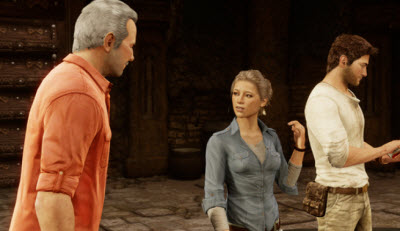 VB: And here in this beginning, it becomes clear that Sully and Drake’s relationship was central to the game, as opposed to a more romantic story of Uncharted 2. What kind of thinking went into getting your focus on that?
VB: And here in this beginning, it becomes clear that Sully and Drake’s relationship was central to the game, as opposed to a more romantic story of Uncharted 2. What kind of thinking went into getting your focus on that?
JR: I think we always found that fans were asking for more Sully, more Sully, more Sully since the first game we did. Amy was really drawn to the idea of where did these guys come from, where did they meet, who is Sullivan to Drake? Is he Drake’s savior? He is Drake’s corruptor in some sense and what does that mean to those two guys and their relationship and how do they actually interact with each other. Why are they the way they are? That is how the game started. We were trying to go there and make the tension between them feel real. It wasn’t just fan service. It was explaining why they were together.
VB: I didn’t really think about that savior and corrupter angle.
JR: Yeah. Would Drake be who he was without Sullivan, and would Sullivan be who he was without Drake? Those are interesting things to look at and play with.
VB: It seems like humor is really part and parcel of the core of this franchise as well?
JR: Definitely. A piece of what we do is the humor of the game. And I think that’s something that’s different. A lot of other games really don’t try to do because it is hard. It is tricky. I think Amy is really good at it. She creates funny and believable characters that you want to sort of go on an adventure with. I think part of that is the humor. How much do people believe these guys and want to see what they are gonna do and how they are reacting to situations.
VB: I really like the graphics and the way the château fire was visualized. Drake and Sully break through a door and they see this wall of flame coming at them. That’s where it really seemed like a step up in the graphics from the past. It seemed much more movie-like.
JR: Thank you. We spent a lot of time working on that stuff. Any of those things where you can push particle effects and rendering and all those at the same time as trying to get the game play in as well — I think that’s where the game really shined.
 VB: And I think that was a step up from the graphics of Uncharted 2 as well.
VB: And I think that was a step up from the graphics of Uncharted 2 as well.
JR: I think so. You tell me. But I think we did a better job on this one with lot of that stuff trying to get more stuff on the screen. We tried to make it even more beautiful,. All of those kinds of things obviously are hugely are important to us.
VB: It seems like one of the trade-offs you always have is, you want to show off outstanding graphics from the right angle, or the exact right perspective, but you also want the player to feel like they’re playing and that they control the character.
JR: Yeah. You always want to feel like you are playing the game. You want to make sure that game play has to win out over everything else. We have to make sure that Amy and I work carefully together trying to make sure that the story that we are trying to tell lines up with the game play. You as they player have to be in control of Drake, especially in those big set pieces at the right time. It is not just a movie. It is something that you are actually interacting with. You are actually playing. When you are on that cruise ship or you are on that cargo plane, you are actually playing Drake. You are not just watching what is happening.
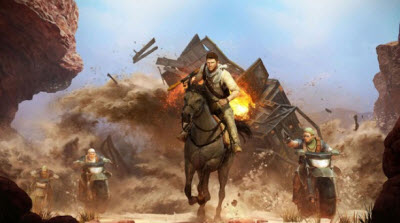 VB: There are some trade offs in the movie angle as well. It seems like, in game play sections, the longer a scene goes on, the happier the gamer is. But, dramatically, it is almost like some of the scenes, if they were in a movie, should last maybe five seconds. As an example, if you jump from a moving truck to a horse in a movie once, that is cool. But if you do that in a game, you might want to do it over and over again.
VB: There are some trade offs in the movie angle as well. It seems like, in game play sections, the longer a scene goes on, the happier the gamer is. But, dramatically, it is almost like some of the scenes, if they were in a movie, should last maybe five seconds. As an example, if you jump from a moving truck to a horse in a movie once, that is cool. But if you do that in a game, you might want to do it over and over again.
JR: Yeah. It is definitely a delicate balance. I mean that’s why we are trying to make sure those things don’t go on and on and on and on. We try to make sure there are sequences where you feel like they are not crazy or they are still fun at the end of the day. You want to leave them wanting more and we try to be pretty careful.
VB: I always had a tough decision figuring out what kind of gun to carry and which gun to leave behind. Is there a tip you have for that?
JR: [Laughs.] It really de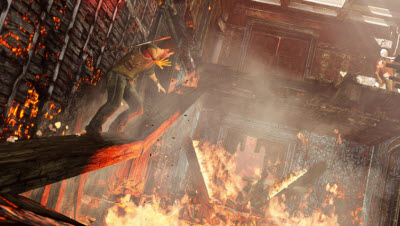 pends on the player. I tend to try to take the GMAL. That is my favorite gun but I have seen players that play the whole game just AK-47. Occasionally they have to pick up a rocket launcher. In general I think all the guns are different and people are encouraged to try to experiment with them. They can figure out which one they like the best. I personally like the GMAL. I always try to keep that. It’s good for both short and long range.
pends on the player. I tend to try to take the GMAL. That is my favorite gun but I have seen players that play the whole game just AK-47. Occasionally they have to pick up a rocket launcher. In general I think all the guns are different and people are encouraged to try to experiment with them. They can figure out which one they like the best. I personally like the GMAL. I always try to keep that. It’s good for both short and long range.
VB: I tended to carry a gun that I thought might be useful if one of the big bosses came up. I felt that if I really needed a gun with a lot of ammo, I could always just kill one of the lackeys and take one of their guns.
JR: Exactly. It pays to have in your back pocket a very powerful gun while carrying something else.
VB: Were those bosses a lot harder this time round?
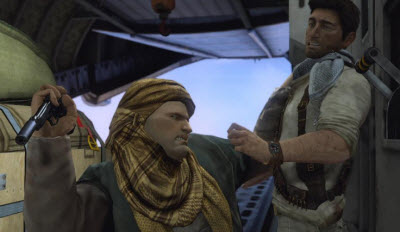 JR: I don’t think so. I mean we try to be pretty careful to balance them. We think overall they were about the same as they were last time. It depends on what scenario you are in and how fast they come at you or how they can move. In the last game, it seemed like they were always stuck in one place. That was one of the complaints. So in this game, they were able to move more. That made it seem like they could move a little faster and that affects the game play. But I think the difficulty of the bosses is less in this game than they were in Uncharted 2.
JR: I don’t think so. I mean we try to be pretty careful to balance them. We think overall they were about the same as they were last time. It depends on what scenario you are in and how fast they come at you or how they can move. In the last game, it seemed like they were always stuck in one place. That was one of the complaints. So in this game, they were able to move more. That made it seem like they could move a little faster and that affects the game play. But I think the difficulty of the bosses is less in this game than they were in Uncharted 2.
VB: I didn’t notice anything in the game about what you guys would do next. Have you ever dropped any kind of hint about whether this is part three in a trilogy or if this goes on and on as a series?
JR: We never set out to make a three-part series from the beginning. We have always sort of seen it as a stand-alone adventure, like you are gonna pick up any one of the games and play and out of order. It still makes sense. You can still understand the characters and the plot. Obviously, if you play the other ones, you get more out of it. I have always seen it as a single-part adventure story. We have always said that if we think that we can make something new and interesting, if the fans still want them, then we can make another one. But at this time, everyone is sort of on vacation. We’re trying to recover from the process of making it and I think we will come back together and maybe this month and next month make a decision about what we are going to do next. But we never said how many of these things there will be. There are plenty more stories in the universe. It is just a question of what’s the company interested in doing next. We really don’t know at this moment.
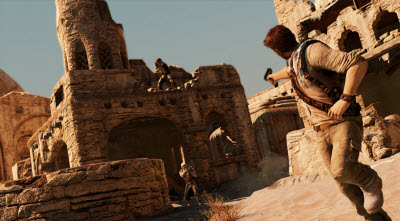 VB: I suppose if you have 500 people on a team like Activision on Call of Duty, then you can do one of these every year right?
VB: I suppose if you have 500 people on a team like Activision on Call of Duty, then you can do one of these every year right?
JR: [Laughs.] Sure. I mean that’s a bit tricky but I think the thing is for us, the reason people love to work here is that everybody is really in direct control over everything they do. The way we make games is say this is what we want to do as a company. We get behind something and go hard on it. So we don’t want to be stuck in a place where people in the company feel like they are trapped on a project and it is something that is not interesting to do. You never get great results that way and so we have always sort of pushed ourselves to try and do something that everybody is interested in doing.
VB: But your fans want something every year right?
JR: Of course. I wish we had the manpower for that. But I think in other sense I think you end up getting intellectual property fatigue. You can get burned out on it, if you don’t have time to innovate on it and make it different each time in some way. People can burn out on the franchise a lot faster.
VB: I never quite remember how long it takes to play these games?
JR: I think the average player takes 10 to 12 hours. But that is comparable for Uncharted 2.
VB: I was partly delirious, since I was playing while sick.
JR: That’s a rough deal.
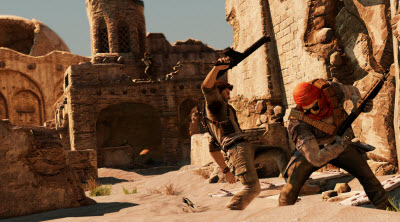 VB: As far as other kinds of tips go, have you been telling people about any particular ways to play the game?
VB: As far as other kinds of tips go, have you been telling people about any particular ways to play the game?
JR: One thing that we encourage people to do is that there is a huge amount of content — if you don’t want to play competitive multiplayer — we also have this cooperative content which is basically five or six short stories in sort of alternate reality version of Uncharted which people can play. We try to encourage people to go and play that stuff in the club section. It is really fun and it has all the favorite characters in there. It has these stories and little moments and sort of the extracts from the single-player campaign, in a light narrative version of that. We are encouraging people to go and play that co-op version because it is fun and we don’t want people to miss out on that just because it is online. It shouldn’t scare people off.
I think you can even actually want to play it on offline mode where you can sit down on the couch and play it split-screen play with a friend sitting right there without him having to log in. But as far as the single-player campaign, I think ideally people find their own way. We try not to be very heavy-handed with tips and so we don’t want to give them up. We want them to experience the play.
VB: How is multiplayer turning out from your perspective?
JR: I think we have got better numbers as last time. I think we got a huge amount of content there. I think it is a lot of fun to play and we offer some things that’s really different from the Battlefield or the Call of Duty games out there. It is a very dynamic battlefield that has a ton of verticality. It has tons of different types of roles you can do. There is a lot of customizability for the look of your character and the types of weapons and game play style that you can use. We had a lot of fun in the office playing. The fans are having fun. From our view, it has gone well.
VB: How do you guys do the rendering of the sand? Did that take some really special expertise to have a firefight in the sand storm?
JR: Actually we sent a bunch of our particle and background artists out to the desert and had them roll around in the sand for a couple of days. We did that because we wanted that to be so realistic. We spent a lot of time making that it felt real and looks real. We wanted you to feel like you are actually inside of that sand cloud and that it is not just something painted on the horizon. It actually affected the game play.
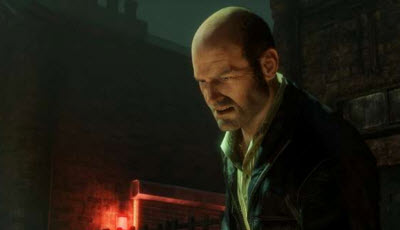 VB: And how did you guys think about adding the new characters and designing for Charlie Cutter and Katherine Marlowe?
VB: And how did you guys think about adding the new characters and designing for Charlie Cutter and Katherine Marlowe?
JR: Basically, we knew we wanted to have this anti-group character, the guy on the inside of the organization. When we got Graham McTavish on the set — he actually played Zoran Lazarevic in Uncharted 2 — and we saw him work with the other characters, we decided we had to blow him out even more and make him an even bigger character. So we did and we ended up actually expanding his part because of the way they interacted with each other on stage. It is always interesting to see. Amy will write something and then do a table read and sit down and we see how the actors play with it. Then we take it from there and sometimes we will get results that we didn’t expect. It’s sort of like seeing the filming of a TV show with the actors performing week after week. It is not like they are recorded and then they leave. They are really living with the project. The actors bring something to it, like Graham did with Charlie and Rosalind Ayres did with Katherine Marlowe.
VB: It’s interesting that the actors have a role in defining these characters that you create for the game.
JR: Yeah. I don’t know how the serials work but I think it is different. We have somebody come in and read for a part. We often have no one there for them to interact with. We think about how this person with interact with Drake’s character. We take it very seriously and often times the actors have great ideas and we listen to them. And often the best comes from the actors just reacting in the moment. That is how collaborative the environment is.
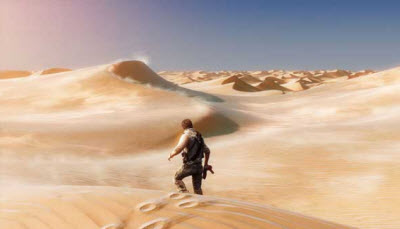 VB: There has been a lot of controversy about this Eurogamer review where the writer criticized the formula and gave it a score of 80 out of 100. How do you feel about the issues that got raised and what is your response to them?
VB: There has been a lot of controversy about this Eurogamer review where the writer criticized the formula and gave it a score of 80 out of 100. How do you feel about the issues that got raised and what is your response to them?
JR: I think it is completely fair review, I think the guy completely backed up his points. In no way was it unfair and I think that’s great we need more of that. I might disagree with his opinion but at least he has valid points and I think he backs it up. The frustrating ones are the reviews where people trash the game and don’t have a reason why. They just say it sucks. I wish there were more people being as thoughtful as that Eurogamer was for sure. I disagree with the score number but I think we need more of that if anything else.
VB: Yes, score numbers are very interesting. I don’t know how they appear from your side of things.
JR: There are an overwhelming number of critics who look at you and disagree with your decisions. I think that is fine. This year is really great because we have so many games out there that are really good. We are just one of a billion other games. In the last two weeks alone, you have got all the crazy stuff coming out.
VB: There is a lot of talk about game of the year again.
JR: Yeah I think that would be nice obviously. I think in terms of games and the fans, as long as people love playing the games, that’s great for us. There is heavy competition this year. I mean Batman is really amazing. Skyrim is amazing. How do you even pick between those games?
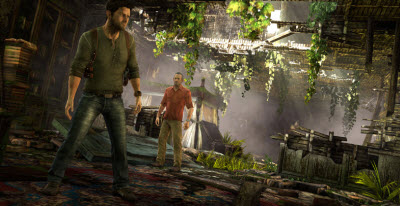 VB: I was curious about the title, Uncharted 3: Drake’s Deception. How did you decide on that?
VB: I was curious about the title, Uncharted 3: Drake’s Deception. How did you decide on that?
JR: Well when we were first talk about it, Amy said she really wanted to put the idea of deception – who do people believe and who is deceiving who and also having a sort of double meaning in the title. The title Drake’s Deception is actually referring to Sir Francis Drake actually deceiving others about where Ubar, or the Atlantis of the Sands, actually was. And then on the other side you have got Nathan Drake actually deceiving his friend to taking him along on this adventure. So we fell for that one. We had a whole list of names and that was the one that popped out immediately. We ran with it.
VB: The whole history was interesting, given the different things you weaved into the story.
JR: We spent a lot of time researching the historical mystery and stuff. We found something to latch on to with T.E. Lawrence. You know he is dead and he wanted to go to the Atlantis of the Sands. On top of that, Sir Francis Drake went sailing around the world, and in real life it took him six months to cross the East Indies and it probably should only have taken him about 30 days. In real life, what probably happened was that he got back to England and waited off the coast for three months just to make sure he wasn’t going to be killed because of the revolution. We wanted to tie it in more to a historical mystery that we made up.
VB: I’m curious about what was fiction and what was real history.
JR: That’s what we always try to do. We try to watch out for something that is real and take it one more step into what is possible.
VentureBeat's mission is to be a digital town square for technical decision-makers to gain knowledge about transformative enterprise technology and transact. Learn More
